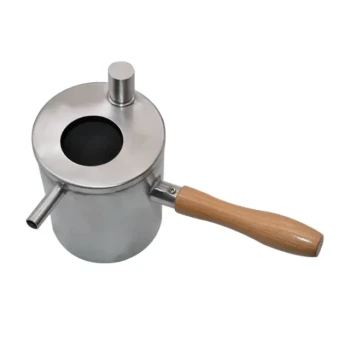At its core, beeswax is a natural polymer produced by honey bees to construct their entire home. Young worker bees secrete this wax from specialized glands on their abdomens and use it to build the iconic hexagonal comb, which serves as the hive's pantry, nursery, and structural foundation.
Beeswax is far more than a simple byproduct; it is a metabolically expensive, self-produced construction material that forms the literal foundation of the hive's social structure, food storage, and future generations.

The Biological Factory: How Beeswax is Made
Specialized Glands on the Abdomen
Honey bees produce wax from eight specialized glands located on the underside of their abdomens. The wax is secreted as small, clear flakes.
A Young Worker Bee's Job
This remarkable ability is limited to worker bees of a specific age. Wax production is most prominent in bees that are between 12 and 20 days old, a stage in their life dedicated to in-hive tasks.
Production On-Demand
Bees do not produce wax continuously. The glands are only activated when the colony perceives a need for new comb, such as during a strong nectar flow or when expanding the hive. This ensures the colony does not waste precious energy resources.
The Hive's Master Material: Primary Uses for the Colony
Building the Comb: A Feat of Engineering
The most critical use of beeswax is for building the comb. Bees meticulously construct a matrix of perfectly uniform hexagons, a shape that provides maximum storage volume with the minimum amount of material.
The Pantry: Storing Honey and Pollen
These wax cells serve as the colony's storage containers. Bees fill them with nectar, which ripens into honey, and pollen. This stored food is essential for the hive's survival, especially during winter or periods of scarcity.
The Nursery: Rearing the Next Generation
The queen bee lays her eggs in these same wax cells. The cells serve as a protected chamber for the larvae and pupae to develop, making the comb the nursery for the entire colony.
Understanding the Trade-offs: The High Cost of Wax
A Metabolically Expensive Process
Producing wax is incredibly energy-intensive. A bee must consume a significant amount of honey to produce a small amount of wax. This high cost is why bees are so efficient with its use and will only produce it when absolutely necessary.
Valued Over Honey
The high biological cost of production is reflected in its economic value. For beekeepers and consumers, beeswax often sells for nearly double the price of honey per pound, highlighting its status as a premium, resource-intensive product.
Beyond the Hive: The Versatility of Beeswax for Humans
In Health and Beauty
Beeswax is a common ingredient in cosmetics, soaps, and ointments due to its moisturizing and protective properties. It acts as a natural emulsifier and provides structure to these products.
In Household and Industry
Its unique properties make it highly versatile. It is used for making high-quality, slow-burning candles, creating natural polishes, and waterproofing wood and leather goods. It also serves as a lubricant for threads and various mechanical parts.
Specialized Applications
Beyond common uses, beeswax is used to insulate high-frequency electrical circuits and is even applied in some food processing applications. For beekeepers, it can be used as a lure to attract swarms of bees.
Key Takeaways on the Importance of Beeswax
- If your primary focus is biology: Recognize that beeswax is a brilliant example of evolved efficiency, allowing a colony to build its entire infrastructure from a substance it produces itself.
- If your primary focus is beekeeping: View wax production as a key indicator of a healthy, expanding colony and a valuable secondary product of the hive.
- If your primary focus is as a consumer: Understand that beeswax is a natural, resource-intensive material whose unique chemical properties make it superior for a vast range of applications.
This single substance demonstrates the remarkable ingenuity and resourcefulness of the honey bee colony.
Summary Table:
| Aspect | Key Information |
|---|---|
| Who Produces It? | Worker bees, 12-20 days old |
| Primary Hive Use | Building honeycomb for food storage & brood rearing |
| Key Human Uses | Cosmetics, candles, wood polish, waterproofing |
| Economic Value | Often double the price of honey per pound |
Equip Your Apiary with HONESTBEE
For commercial apiaries and beekeeping equipment distributors, a consistent supply of high-quality beeswax is essential for hive health and productivity. HONESTBEE supplies the durable beekeeping supplies and equipment you need to support your colonies' natural wax production and manage your harvest efficiently.
Contact our wholesale team today to discuss your needs and learn how our products can help build a stronger foundation for your business.
Visual Guide

Related Products
- Beeswax Melter for Candle Making Honey Bee Wax Melter
- Steam Beeswax Melter Wax Warmer for Wax Processing
- Professional Stainless Steel Wax Melter for Beekeeping and Crafts
- Honey Wax Separating Wax Press with Metal Screw Wax Separator Machine
- Electric Flatting and Embossing Machine with Tray for Beekeeping
People Also Ask
- What makes polyurethane foam environmentally friendly? The Surprising Benefits of a Durable, Inert Material
- What do you use a wax melter for? From Home Fragrance to Professional Beekeeping
- How does a steam wax melter work? A Fast, Efficient Method for High-Quality Wax
- What are the benefits of using a professional wax melter? Achieve Consistent, Scalable, and Safe Production
- What is the flashpoint of beeswax? Essential Safety and Quality Tips for Beekeepers



















